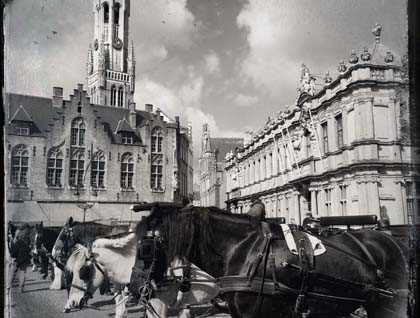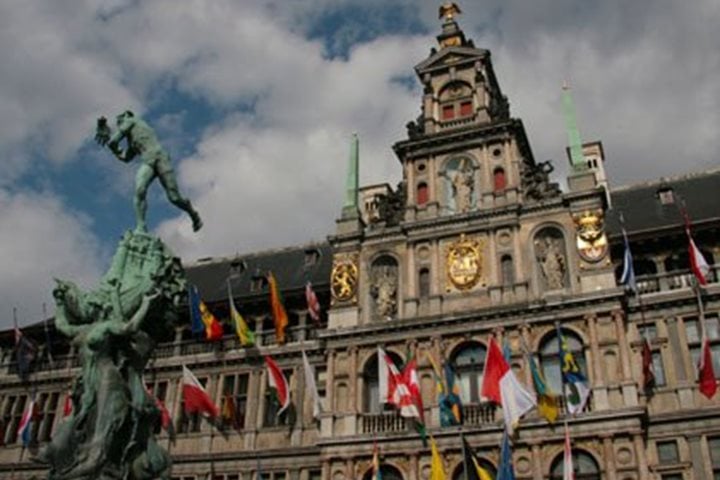An uninformed visitor to Bruges, one of northern Europe's best-preserved medieval cities, would be forgiven for thinking it was a meticulously-constructed theme park. So magnificent are its buildings, its cobblestone streets so endlessly beguiling, its winding canals so romantic it seems almost too good to be real. But real it is, and even though Bruges is overflowing with tourists seeking to soak in its charms, it is a living, breathing city whose unequaled architecture is a reminder that Bruges has long been an epicenter of commerce and culture.
Our day began in Oostende, Belgium's most popular seaside resort, where we disembarked to the rousing sounds of a local old-timers brass band. Their jazzy swing led us to sashay into buses where we embarked on a short drive to Bruges.
Ever since its heyday, from 1200 to 1400, Bruges has been well adapted to visitors. No longer do outsiders have to pass through the imposing stone ports that once guarded its wealth, as a medieval traveler would have had to do, rather we entered the city along a tranquil, tree-lined canal.
Once we crossed the canal that nearly fully encircles the city, we were transported back in time. When walking through Bruges, it does not take much imagination to picture oneself in another era. Our route took us through the Begijnhof, which served as a residence for single women for many centuries. Begijns were not nuns, they were unmarried or widowed women who chose to live in a community of peers. The grounds were peaceful and immaculate, and provided a level of freedom and independence that must have been uncommon for women of the era.
From there, we wandered our way through the picturesque streets, across ancient bridges, past tough-looking swans, drinking fountains for horses, a local brewery and a primeval bathhouse. We enjoyed a brief boat ride in the canals, which offered stunning views of the cities Gothic architecture, although we needed to be careful to duck when passing under the low-arched bridges lest we ended up literally losing our heads in Bruges.
After our charming boat ride, we continued to enjoy walking along the streets of Bruges, passing one picture-postcard image after another. Our visit took us to the Basilica of the Holy Blood, which supposedly houses a piece of cloth soaked in the blood of Jesus Christ. The vial was brought to Bruges in the 1200s by a soldier returning from the Crusades, and the golden statue of this knight holding a raised sword is a reminder of how long the struggles for control over Jerusalem have been a part of human history.
While Bruges is filled with important historical sites, monuments, and art museums, the city's charisma is best appreciated by simply wandering aimlessly through its streets. There is no better city in the world for letting yourself get lost; a breathtaking site awaits around every corner. And should you ever need to find yourself again, you need merely look up in the sky and wander your way back to the tower that guide all travelers towards the central market square.
Bruges has much more going for it then architecture. It is also filled with culinary delights, from the ubiquitous chocolate shops, to the guilty pleasure of a crispy Belgian waffle (locals have them plain, but you can add whipped cream, strawberries, chocolate sauce, or all of them if you so desire!) to the fine dining to be had at one of the city's excellent restaurants (Bruges is home to three restaurants with three Michelin stars, a very impressive achievement). I myself had one of the best lattes I've ever enjoyed at a trendy local coffee bar. We were let loose from our guides to enjoy the city on our own, find a good lunch spot, and wander freely until the time came to meet up again and head back to the buses that carried us to the National Geographic Explorer.
Very few completely preserved cities such as Bruges still exist. Most have been left to ruin, modernized, or destroyed by one of the many wars that have plagued Europe, and Belgium in particular. Apparently, Bruges was spared from bombing during World War II by a German commander who realized that destroying a city as beautiful as Bruges would be an irreparable loss to humanity. We can all be thankful that a city as magnificent as Bruges was spared and that it can still be visited today, and hopefully, for generations to come.






